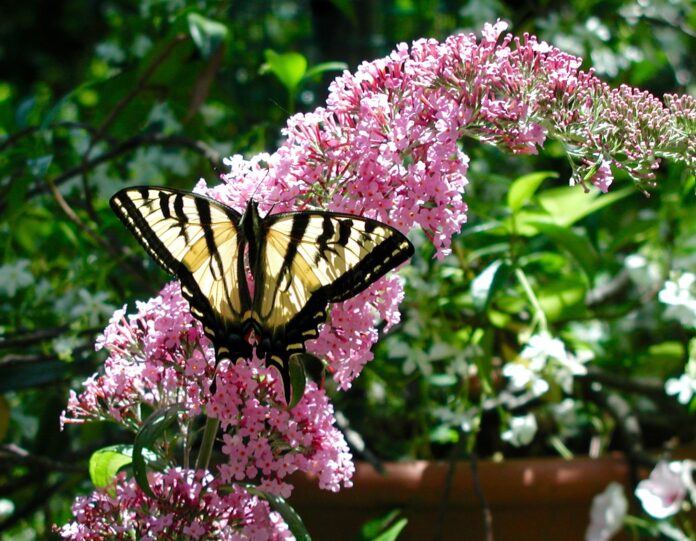Butterflies are magical creatures. They captivate us with their beauty and freedom of flight. Often I’m asked when designing a garden to include plants that will attract them and design areas to provide habitat. Recently there was a hatch of orange Militta Crescent butterflies in our area. I’ve seen hundreds of them up here in Bonny Doon alone. What can I do to increase the chances of them sticking around ?
We have about 90 species of butterflies in the Monterey Bay area. Many of these occur only in our mountains, forests and chaparral environments. They are easy to attract and make a permanent feature of your landscape.
A butterfly garden should include plants that accommodate all stages of the life cycle – egg, larvae, pupa and adult. When both adult nectar and larval host plants are available, they will attract and support a butterfly population. In addition to the right plants, your garden should also have sun, a water source, protection from wind and clusters of plants. When maintaining your garden avoid the use of insecticides, including BT.
As adults, most butterflies feed on the nectar of flowers. Some local butterflies, however, like the Mourning Cloak and Red Admiral, feed primarily on rotting fruit or tree sap for moisture and nutrients and the California Sister also feeds on aphid honeydew.
In the larval stage, most butterfly species are limited to a single plant family and occasionally a single genus. To attract more Western Tiger Swallowtails, for instance, provide larval host plants such as willow, sycamore, alder, Big Leaf maple, sycamore, plum and ash. Common Buckeye lay their eggs on mimulus and verbena while California Sister prefer coast and canyon live oak. Planting a variety of grasses, perennials and shrubs like ceanothus, buckwheat, coffeeberry, bush lupine, manzanita. redwood violet, California aster and wallflower will attract many of the local butterfly species. If your garden is near a wild area that naturally supports the caterpillar stage, you can plant just the nectar plants to attract butterflies to your garden.
Filling your garden with nectar producing flowers is the fun part. Adult butterflies rely on sugar-rich nectar for their daily fuel. Different species have different flower color and shape preferences. Many butterflies produce scents that attract the opposite sex and many of these scents smell like the flowers that they are attracted to and visit. The scent of these butterfly pollinated flowers may have evolved as an adaptation to ensure their survival. Did you know that butterflies taste with their feet.
Butterflies typically favor flat, clustered flowers that provide a landing pad although larger butterflies can feed on penstemon and salvias while hovering. Butterflies have good vision but a weak sense of smell. Unlike bees, butterflies can see red and are attracted to brightly colored flowers. Pink, red, orange, yellow and purple are the most attractive nectar source colors but they also use blue and white.
Consider the blooming time of each plant. Having plants blooming in the sun for many hours in the day will lengthen your viewing time. Nectar rich flowers include yarrow, aster, verbena, scabiosa, buckwheat, toyon, salvia, erysimum, zinnia, lantana and coneflower.
In addition to nectar, butterflies need a source of water and salts. A patch of mud kept wet year round or a shallow depression lined with pebbles and kept moist will work fine. Also provide some flat rocks for them to bask in the sun in an area protected from the wind by shrubs.
Having your own butterfly garden will enable you to witness close-up the wonder of butterflies and the flowers on which they feed.












